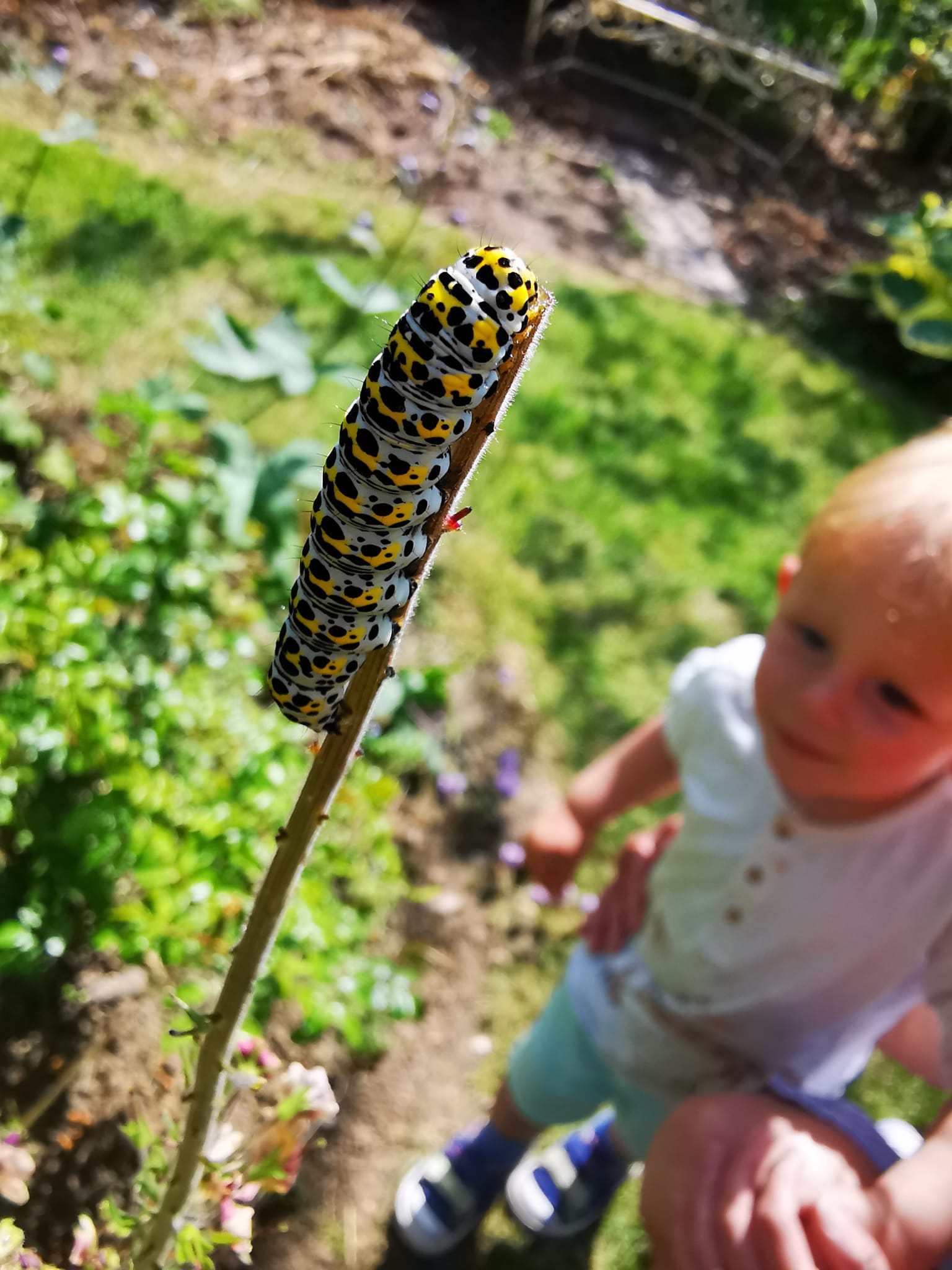Toddler with a Mullein moth caterpillar in the foreground
Butterflies need your help more than ever, says Jo Bower, Communications Manager at Butterfly Conservation, which is why it’s so important to take part in the Big Butterfly Count this year.
It’s a wonderful moment when you see your first butterfly each spring. For me it’s usually a Brimstone in the garden, bobbing along the shrubbery. More recently, my garden has been a haven for Holly Blue, its silvery flashes hard for the eye to follow as they ascend through the foliage, which also appears to be home to a gang of angry, messy blackbird chicks who’ve just fledged. My toddler shrieks ‘Butterfly!’ and we dash to keep the tiny flying creature in our sights as long as possible.
I’m proud of taking part in our Wild Spaces campaign to make space for nature in my garden. Small but thriving ecosystems make themselves known as the weather (finally) starts warming up. Our crazy corner of nettles, holly, ivy and all sorts of other plants is supporting caterpillars, which are in turn supporting those funny fledglings, and we even have a little bat which flits about as the sun goes down. I may live in the suburbs, but we have a slice of green heaven all to ourselves.
A couple of days ago we discovered a tiny caterpillar in the house, squirming and wriggling to my son’s delight on the end of his little fingers. ‘Gently now,’ I reminded him, hoping it wouldn’t succumb to the same fate as the little ant we discovered on the geranium yesterday. It didn’t, and was deposited carefully in the garden. Hopefully I’ll be adding it to my Big Butterfly Count in a few weeks’ time.
Challenging conditions
The Big Butterfly Count is here again and, honestly, we don’t know how it will go this year. In short: we need your help. Firstly, we have had an unusually cold spring, which we believe has caused some species to emerge late. Along with the droughts of last summer, we’re unsure what impact this will have on many of our common species this year.
By the end of June, our UK Butterfly Monitoring Scheme (UKBMS) Programme Lead is poring over the monitoring data from this year so far, and comparing it to the last 10 years to see what trends we might expect. At the time of writing, we don’t know, but things look uncertain. The more data we can collect, the better we can measure how butterflies are faring.
Secondly, the number of people taking part in surveys like these seems to be dropping. Now that the Covid-19 lockdowns are a distant memory (thankfully), it seems that people are becoming less likely to get involved in citizen science. This is happening across the board where the public are asked to help monitor our wildlife. Perhaps people have less time now, less inclination, or are just simply tired of hearing about the biodiversity crisis. Last year was an average one for butterflies, which doesn’t help things either. It sort of makes sense, though – if you don’t see any butterflies, why would you count them?
The bigger picture
But we still need to know how they’re faring. We have to monitor how species are doing, even if it’s to say they’re not there. And there are great benefits for people, too.
For the first time, this year we will be able to cite evidence from Derby University that shows taking part in activities like the Big Butterfly Count has a positive effect on our mental health (more to follow on that soon).
Our Ambassador, Dr Amir Khan, often talks publicly on this topic – the restorative and positive effects on our health of being in a green environment and taking time to notice our natural world. Reducing stress hormones, revitalising our bodies through gentle exercise and the satisfaction that comes with creating a habitat that attracts nature, from a window pot to an allotment. Perhaps, rather than a reminder of the biodiversity crisis we face, the Big Butterfly Count is actually a prescription for wellbeing. It certainly is a highlight in our calendars.
This year we will be launching the Big Butterfly Count on 14 July with Dr Amir Khan and our Vice President, Chris Packham. We’ve chosen a beautiful open-air location in Hampshire. Hopefully the weather will be with us (never fear, we do have a gazebo) so that we can spread the word across the media, with help from staff and members across the UK, about the wonder of nature on our doorsteps. Please keep an eye, and ear, on your TV screens, radios and our Facebook page for live interviews, butterfly spotting and moth trap results. It’s going to be joyous.
It’s important to all of us that we keep sharing that joy in butterflies and moths and preserve it for the future. I want my son to be running around the garden chasing Holly Blues and delighting in wriggling caterpillars with his own children for years to come. This Big Butterfly Count feels like a particularly important one, for nature and for humans. Please take part.
The Big Butterfly Count takes place 14 July–6 August. Submit your findings on the app or download an ID sheet and enter your count at bigbutterflycount.org.


